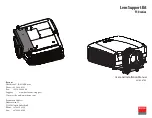
6RL SERIES OPERATION MANUAL
SECTION 7: REMOTE PROGRAMMING
Entire Contents Copyright
2018 by Adaptive Power Systems, Inc. (APS) • All Rights Reserved • No reproduction without written authorization from APS.
6RL Series Regenerative DC Load Operation Manual
Page 118 of 204
7.3.3
Fragmented messages on serial transmissions
With RS232, Ethernet or even with USB it is possible, that the unit receives fragmented
messages. This means, a command is received in pieces together with a certain time gap and
then interpreted by the unit as multiple, but single and incorrect commands. Primarily SCPI
commands are affected, because they are strings consisting of ASCII characters and do not
have a checksum. Those strings could be sent by a serial interface character by character or
as one single block, depending on the situation on the control side (PC). If a certain timeout
elapses between two consecutive bytes, the message is considered as "completely received"
by the unit, due to the lack of a termination character, which is not generally required for
ModBus or SCPI.
A variable USB timeout has been implemented, which can be configured manually on the
unit or via remote control, for example via SCPI. If the communication between PC and unit
has a lot of communication errors due to possibly fragmented messages, the timeout should
be increased incrementally to eliminate the problem. It is advised to keep the timeout
setting as low as possible, because at the end of every message the timeout has to elapse
before the unit can process the command.
When using SCPI, sending an additional termination character (typical LF, CR, or CRLF
accepted), which is not required but accepted, will terminate the timeout immediately and
let the unit consider the message as completely received, so it can be processed.
7.3.4
Connection Timeout
Socket connections to units which support an Ethernet port have a connection timeout. This
variable and user-adjustable timeout closes the socket connection automatically on the
device side if there was no communication going on between device and controlling unit
(PC, PLC etc.) for the adjusted time. After the socket has been closed, connection can be
established again at any time.
7.3.5
Effective Programming Resolution
All values related to voltage, current, power and resistance, that can be transferred to the
unit and which are transferred via the power stages from the input of the unit have the
same defined programmable resolution and an effective resolution. While the
programmable resolution of a value is the same for every series (0-100 % = 0 - 0xCCCC = 0 -
52428), even when using SCPI, the effective resolution depends on the ADC/DAC used in the
hardware which is 16 bits for the 6RL Series.
The effective resolution determines the doable step width on the DC Input/input. It
calculates as step width = rated value ÷ effective resolution. For 6RL15-510-80-4 model, the
approximate step width of voltage is 80 V / 26214 = ~ 3 mV. For the current it would be 510
A / 26214 = ~19 mA.
However, tolerances add to the result when setting a value. The 6RL15-510-80-4 from the
example above has a voltage tolerance of max. 0.1%, as stated in this manual. This is up to
80 mV. When setting, for example, 24 V the true output voltage is allowed to be within
23.92 V to 24.08 V range. The actual value, as readable from the unit, already includes this
Содержание 6RL Series
Страница 203: ......
















































